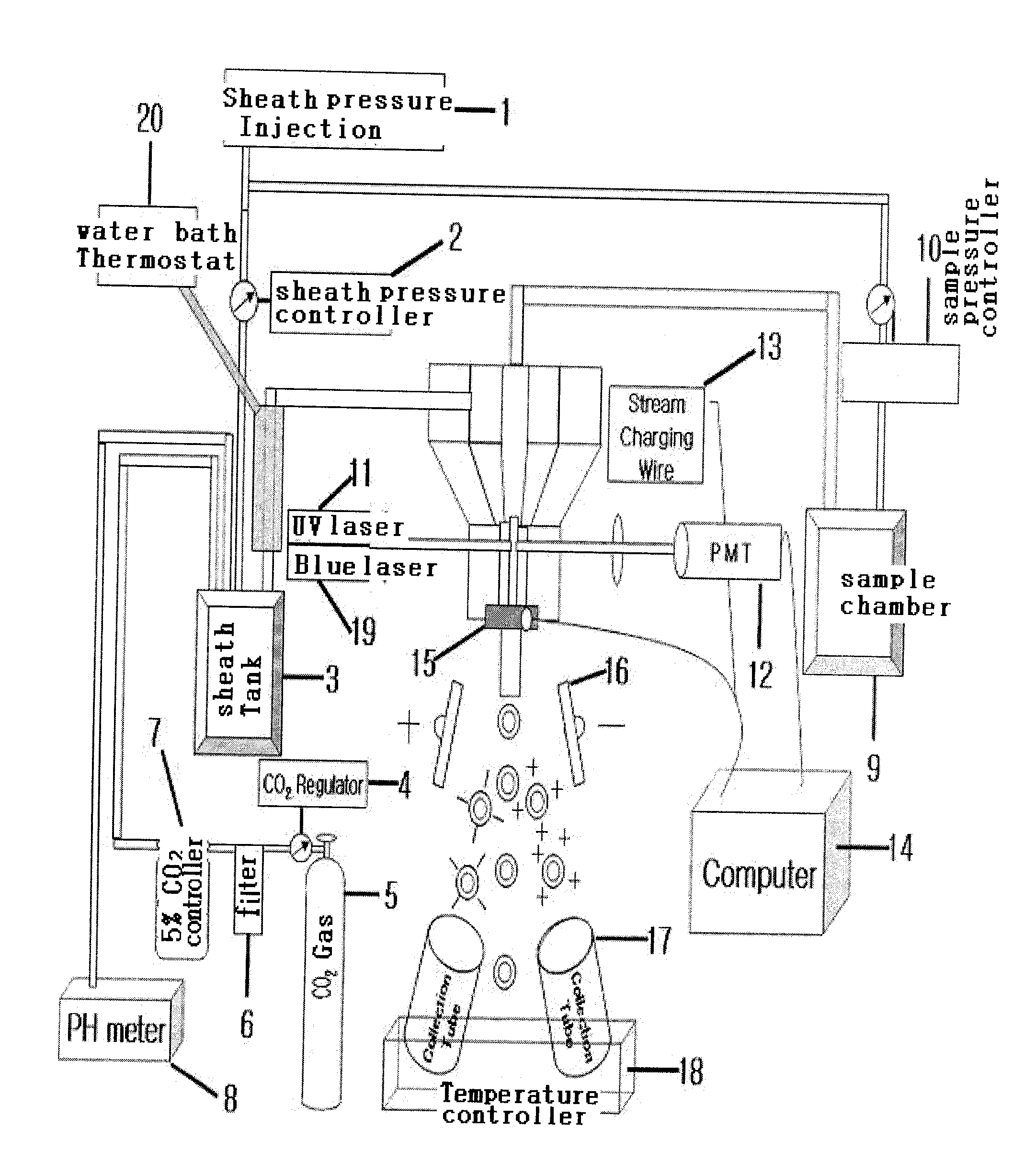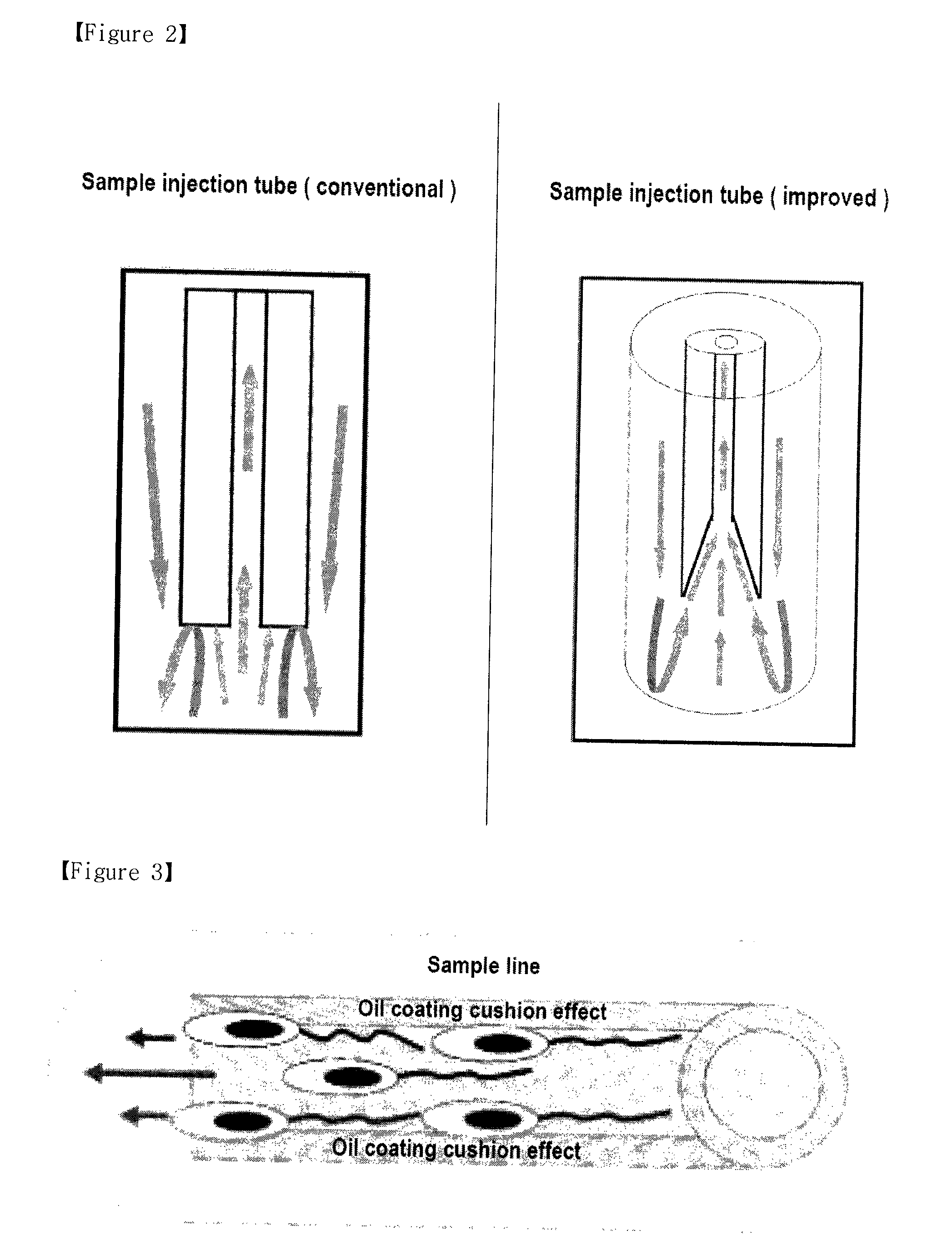Parameter for x- and y- chromosome bearing sperm sorting with high degree of purity
a sperm and purity technology, applied in the field of new sperm sexing methods, can solve the problems of low purity, inability to obtain high purity sperm population by the methods described above, questionable purity and fertility of sorted sperm, etc., to achieve enhanced sorting purity, restrain sperm motility, and enhance the effect of sorting purity
- Summary
- Abstract
- Description
- Claims
- Application Information
AI Technical Summary
Benefits of technology
Problems solved by technology
Method used
Image
Examples
example 1
The Preparation of Semen Extender
[0050]The formula of the extender used for this invention is like this.
TABLE 11X SaltsIngredientsgm / 1000 mlfinal Conc(mM)NaCl5.53494.59KCl0.3564.78CaCl20.1891.71KH2PO40.1621.19MgSO4•7H2O0.2941.19NaHCO32.10625.07
[0051]The formula of the media for sperm motility and viability is like this.
TABLE 250X MetabolitesIngredientsmg / 20 ml1X Conc.(mM)Na lactate260823.28Na pyruvate360.33Glucose10005.56Penicillin62.1100U / mlStreptomycin5050g / ml
This solution was used to maintain pH.
TABLE 320X Hepes-NaClIngredientsgm / 5 mlgm / 10 mlNaCl0.9001.8Hepes0.23830.476
example 2
Sex-Dependant Sorting of Mouse Sperm
[0052]The sex-specific sorting of sperm was conducted using BD FACSAria. Mouse semen was collected and mixed with semen extender, nutrients, and buffering reagents shown in a comparative example 1. Sexually mature mouse (strain C57 BL or ICR) was inhaled with CO2 gas and then killed by applying fracture of cervical spine. Subsequently, epididymis and seminal ducts were dissected out, submerged in 2 ml of extender, sliced into smaller pieces, and incubated in CO2 incubator for 15-20 minutes to allow sperm to be released from the dissected tissues. Released sperm were stained with a DNA binding fluorescence dye, bisbenzimide (5 ug / ml) by using swim up method in 5% CO2 at 34° C. for 30 minutes. Sheath pressure was adjusted to 20 psi, CO2 was supplied by directly connecting CO2 tank to the sheath solution tank, pH was maintained near 7.4. Sperm were stained with fluorescence dye, bisbenzimide (5 ug / ml) and illuminated with UV laser (˜340 nm) and blue ...
example 3
Analysis of the Separation Efficiency of Sperm Using FISH (Fluorescence in Situ Hybridization)
[0054]To confirm that the method is working, probe #1 specific to chromosome 1 (TCT CGG CTT TGT TTT ATT TTG TTT TGG TTT) was labeled with FITC and used as a control. Probe #2, specific to chromosome Y, (TAC CCA AAC TAT AAA TAT CAG CCT CAT CGG) was labeled with Cy3 and used to detect sperm containing chromosome Y. About 200000 of sex-sorted sperm were transferred to 1.5 ml tube containing 200 ul of buffer solution (0.1M Tris-HCl). Sperms were incubated for 10 minutes and washed with 2×SCC buffer for 5 minutes twice. To de-condense over-concentrated nucleus, 200 ul of dithiothreitol (DTT, 2 mM) solution (pH 7.4) was added and the mixture incubated for 15 minutes at 37° C. After that sperm were washed twice with 2×SSC buffer and dried at room temperature. Subsequently, hybridization solution (28 ul), FITC-probe (2 ul), Cy3-probe (2 ul), and distilled water (4 ul) were added to visualize partic...
PUM
| Property | Measurement | Unit |
|---|---|---|
| temperature | aaaaa | aaaaa |
| temperature | aaaaa | aaaaa |
| temperature | aaaaa | aaaaa |
Abstract
Description
Claims
Application Information
 Login to View More
Login to View More - R&D
- Intellectual Property
- Life Sciences
- Materials
- Tech Scout
- Unparalleled Data Quality
- Higher Quality Content
- 60% Fewer Hallucinations
Browse by: Latest US Patents, China's latest patents, Technical Efficacy Thesaurus, Application Domain, Technology Topic, Popular Technical Reports.
© 2025 PatSnap. All rights reserved.Legal|Privacy policy|Modern Slavery Act Transparency Statement|Sitemap|About US| Contact US: help@patsnap.com



